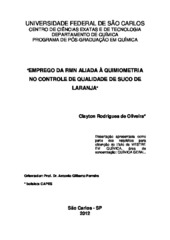| dc.contributor.author | Oliveira, Clayton Rodrigues de | |
| dc.date.accessioned | 2016-06-02T20:36:43Z | |
| dc.date.available | 2013-03-11 | |
| dc.date.available | 2016-06-02T20:36:43Z | |
| dc.date.issued | 2012-03-30 | |
| dc.identifier.citation | OLIVEIRA, Clayton Rodrigues de. Quality control in orange juice using nmr and chemometrics.. 2012. 103 f. Dissertação (Mestrado em Ciências Exatas e da Terra) - Universidade Federal de São Carlos, São Carlos, 2012. | por |
| dc.identifier.uri | https://repositorio.ufscar.br/handle/ufscar/6548 | |
| dc.description.abstract | Fresh orange juice is widely appreciated all over the world for its pleasant flavor and because it is a great source of nutrients. Currently, Brazil leads the world in the production and export of orange juice, generating billions of dollars each year. Therefore, the purpose of this paper is to describe the application of 1H NMR in combination with chemometrics in order to characterize the chemical properties of commercial juices and to compare them with natural juices from the main types of Citrus sinensis cultivated in Brazil and bought in the local market. Moreover, the degree of alteration and the variation in concentrations of derived chemical constituents of commercial and natural juices in different storage conditions were evaluated. Hence, three (3) samples of commercial juices and five (5) types of natural juices extracted from pêra Rio oranges (C. sinensis (L.) Osbeck), Bahia oranges (C. sinensis (L.) Osbeck), murcote oranges (C. grandis (L.) Osbeck), lima oranges (C. aurantifolia), and lima da Pérsia oranges (C. aurantifolia) were studied. The 2D and 1H NMR techniques had proved to be an important tool for characterization and relative quantification of the main metabolites that are found in the alteration of natural and commercial orange juice samples of this study. The application of these techniques has allowed the characterization of twenty seven (27) metabolites present in orange juice samples examined herein. The results showed that the absolute quantification of ethanol and the relative quantification for formic, fumaric, lactic, acetic, pyruvic, and succinic acids indicate that these compounds changes in the orange juice occurred during the storage period and conditions. Furthermore, principal components analysis (PCA) was used to classify commercial and natural orange juice through quantification of major and minor metabolites present in juices. | eng |
| dc.description.sponsorship | Financiadora de Estudos e Projetos | |
| dc.format | application/pdf | por |
| dc.language | por | por |
| dc.publisher | Universidade Federal de São Carlos | por |
| dc.rights | Acesso Aberto | por |
| dc.subject | Química quantitativa | por |
| dc.subject | Ressonância magnética nuclear | por |
| dc.subject | Quimiometria | por |
| dc.subject | Suco de laranja | por |
| dc.title | Emprego da RMN aliada à quimiometria no controle de qualidade de suco de laranja | por |
| dc.title.alternative | Quality control in orange juice using nmr and chemometrics. | eng |
| dc.type | Dissertação | por |
| dc.contributor.advisor1 | Ferreira, Antonio Gilberto | |
| dc.contributor.advisor1Lattes | http://genos.cnpq.br:12010/dwlattes/owa/prc_imp_cv_int?f_cod=K4721956Y6 | por |
| dc.description.resumo | O suco de laranja é o mais apreciado mundialmente, principalmente por causa do seu sabor agradável e por ser uma fonte rica em nutrientes. Atualmente, o Brasil é o maior produtor e exportador mundial de suco de laranja, além de gerar divisas da ordem de bilhões de dólares por ano. Com isso, o objetivo desse trabalho foi a aplicação da RMN de 1H, aliada à quimiometria, para traçar um perfil dos constituintes químicos existentes nos sucos comerciais e compará-los com os sucos naturais das principais variedades de Citrus sinensis cultivadas no Brasil e ofertadas no mercado local. Também foi avaliado o grau de alteração e a concentração dos constituintes químicos oriundos dessa variação nas amostras de sucos comerciais e naturais em diferentes condições de armazenamento. Portanto, foram estudadas três (3) amostras de sucos comerciais e cinco variedades de sucos naturais das laranjas pêra Rio (C. sinensis (L.) Osbeck), Bahia (C. sinensis (L.) Osbeck), murcote (C. grandis (L.) Osbeck), lima (C. aurantifolia) e lima da Pérsia (C. aurantifolia). As técnicas de RMN de 1H e 2D mostraram-se uma importante ferramenta na caracterização e quantificação relativa dos principais metabólitos provenientes da alteração das amostras de sucos de laranjas naturais e comerciais estudadas. Essas técnicas utilizadas possibilitaram caracterizar vinte e sete (27) metabólitos presentes nas amostras de suco de laranjas estudadas. Os resultados obtidos para a quantificação absoluta do etanol e a relativa para os ácidos: fórmico, fúmarico, lático, acético, pirúvico e succínico indicam que esses metabólitos são provenientes de alterações ocorridas no suco de laranja durante o período e o tipo de armazenamento. Além disso, foi possível discriminar suco de laranja comercial e natural através dos metabólitos majoritários e minoritários presentes no suco por análise de componentes principais (PCA). | por |
| dc.publisher.country | BR | por |
| dc.publisher.initials | UFSCar | por |
| dc.publisher.program | Programa de Pós-Graduação em Química - PPGQ | por |
| dc.subject.cnpq | CIENCIAS EXATAS E DA TERRA::QUIMICA | por |
| dc.contributor.authorlattes | http://lattes.cnpq.br/7172297688805316 | por |
